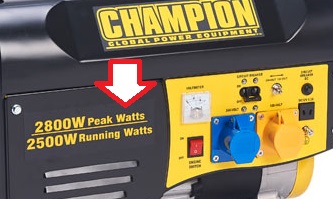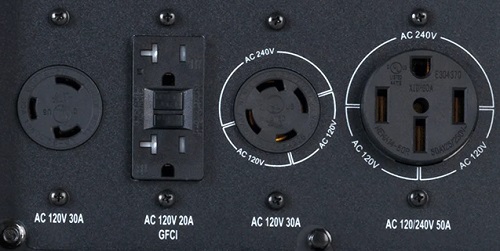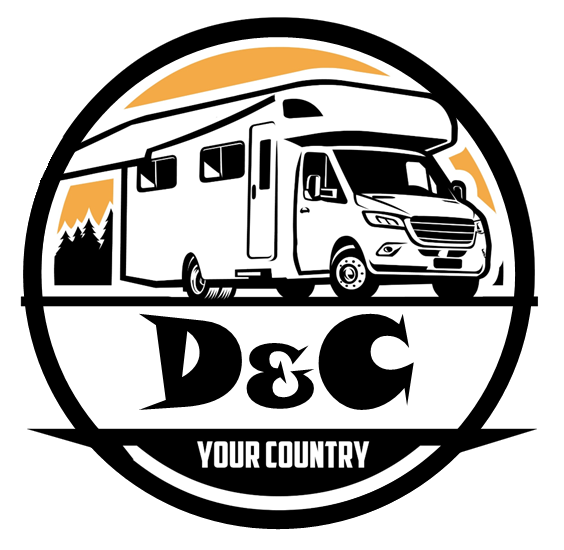![]()
What Size Generator do I Need for a 50-amp RV?
DISCLAIMER: AS AN AMAZON ASSOCIATE I EARN FROM QUALIFYING PURCHASES. THIS POST CONTAINS AFFILIATE LINKS THAT WILL REWARD ME MONETARILY OR OTHERWISE WHEN YOU USE THEM TO MAKE QUALIFYING PURCHASES. FOR MORE INFORMATION, PLEASE READ MY EARNINGS DISCLAIMER.
|
50 amp is a service where two parallel 50-amp circuits are wired to give you 120/240VAC output and this means that the maximum power that your RV can handle is 12,000 watts (6,000 on each leg). A 6,000-watt generator (or two 3,000-watt generators in parallel) is usually sufficient to run 2 A/C and some other appliances if you use a soft-start technology for handling startup surges.
Since getting a 12,000 generator could be pricey (not to mention, it’s very heavy), many people do NOT use this size of generator in the RV. In fact, a lot of factory-built-in generators are about 5,500-6,000 watts and for most people, it is good enough to run two air conditioners along with a microwave oven and a few lights.
The most common size of RV air conditioner needs about 1,300 watts to run on, but when the compressor cycles, its demand surges up to two times (or a bit more than that amount). This is why it is possible to start and run an air conditioner on a generator with a 2,800-watt surge rating.

After the initial surge, your power demands for a single A/C will go back to the normal 1,300 watts. For two air conditioners, a generator double this size will be needed or two 2,800-watt generators wired in parallel.
If you would like to use other appliances along with your air conditioners, you may want to consider getting a soft starter (some paid link) that is made specifically for RV:
The minimum size generator for 50-amp RV service should be 5,000-watts and the largest generator that most people get is about 7,000-watts. Using two smaller generators and paralleling them is also a possibility if you find it easier to lift and store a smaller-sized generator than a big one.
You can also add an inverter charger to your backup power setup and if it’s a model with power assist mode, it will give your air conditioner an energy boost from the battery bank when the condenser kicks in. Victron Energy MultiPlus 3000VA (some paid link) works really well for that particular purpose:
Here is how this hybrid/power assist mode works:
If you do decide to get two smaller generators instead of the big one, it is more common that inverter-type generators will have a paralleling capability built-in. In some cases, the manufacturer will allow you to parallel generators of different sizes (which is quite convenient).
Here is a good overview of that:
When interconnected, you will get a full amount of power from both generators via a 30-amp or 50-amp outlet (sometimes both). Below is a paralleling kit from Wen (paid link):
When you use a single generator, your receptacle panel will look like this:

… and you will have a big variety of outlets that you can use individually to power different circuits in your RV. If your generator is supplied with a 50-amp outlet, you can use a 50-amp receptacle and plug in your main cable to power your RV as you normally would from the shore power.
Most generators with a 5,000-watt or higher output feature a four-wire L14-30 twist-lock 120/240 30-amp receptacle, which can be adapted to your 50-amp receptacle and give you 30 amps per leg:

On smaller-sized generators that do not have 120/240 receptacles, you can use a regular or twist-lock 30-amp receptacle with a dogbone adaptor. Don’t forget that all 30-amp receptacles will be protected by a 30-amp breaker and you should limit your usage accordingly.
In this case, prioritizing power consumption is very important in order not to go over your amperage rating. It is also a good idea to make sure that any of the appliances that can work on gas (like water heater or fridge), will be switched to GAS.
You will only get as much power as your generator can offer and if you need a real 50-amp service, that would require a 12,000-watt generator (two 120-volt circuits each with a 50-amp capacity):
120-volts x 50-amps x 2 = 12,000-watts
There are not many RVs that use this kind of generator and for good reasons! It is heavy, bulky, noisy and you don’t really need so much power! There is also an adapter that could turn two outlets (30-amp and 15-amp) into a 45-amp power service with a 50-amp receptacle if you find that 30 amps are way too little.
People say that it works really well with the shore power where 50-amp outlets are not available. Never tried it myself, but I don’t see a reason why it would not work with a generator. Here is this 30+15 amp adaptor from Camco (paid link):
A full 50-amps is usually provided by an onboard generator, but most RVers are getting by quite well on 30-amp service without sacrificing their A/C units. Everything comes down to the right setup.
If you are willing to spend so much money on the generator, think of weight and size! Did you know that you have very valuable Real Estate on your roof?
A perfect generator size for 50-amp RV service doesn’t have to be the biggest if it accommodates other tools like:
- Soft Starter. To “dampen” surges during startup and when the condenser kicks in.
- Inverter-charger with Power Assist mode. It will help you utilize the battery power any time you need to go over the limit of your generator capability. You can also use this to set up a generator NOT to run at full power (due to efficiency loss).
- Solar panels that will refill your battery bank! Why waste roof space, when you can utilize it to charge your batteries and have an ultimate boondocking machine!
This basically means that you can actually get away with using a smaller-sized generator! Technology rules!

50-amp generators are heavy!
If you are searching for a portable generator with over 5,000 watts that is lightweight, you will not find any! If you want to utilize the full 12,000 watts, you are probably looking at about 700+ pounds (see below)!
The most popular model for 50-amp RV service generators is the Cummins Onan model. It requires an external tank, which is usually ok if you can use the tank of your own RV. If you have a 5th wheeler, you will require a fuel tank installation.
It also doesn’t drain your main tank completely and will shut off before you run out of fuel. About 1/4 of the tank capacity will be left for you to drive up to the nearest gas station to refuel.
LP and Gasoline Onan generators
Here is some weight info on Onan LP gas and gasoline generators (some paid links below):
| Model | Surge Watts / Running Watts | Dry Weight |
| QG 2800 RM | 2,800 / 2,500 | 107 lb |
| QG 2500 RM LP | 2,800 / 2,500 | 107 lb |
| QG 2800 | 2,800 / 2,500 | 113 lb |
| QG 2500 LP | 2,800 / 2,500 | 113 lb |
| QG 4000 | 4,000 / 3,600 | 172 lb |
| QG 3600 LP | 4,000 / 3,600 | 172 lb |
| QG 5500 | 5,500 / 5,500 | 279 lb |
| QG 5500 LP | 5,500 / 5,500 | 279 lb |
| QG 5500 EFI | 5,500 / 5,500 | 279 lb |
| QG 7000 | 7,000 / 6,500 | 290 lb |
| QG 6500 LP | 7,000 / 6,500 | 290 lb |
| QG 7000 EFI | 7,000 / 7,000 | 290 lb |
Diesel Onan generators
Here is some weight info on Onan diesel generators (some paid links below):
| Model | Surge Watts / Running Watts | Dry Weight |
| QD 3200 | 3,200 / 3,200 | 205 lb |
| QD 6000 | 6,000 / 6,000 | 420 lb |
| QD 5000 | 5,000 / 5,000 | 400 lb |
| QD 8000 | 8,000 / 8,000 | 420 lb |
| QD 10000 | 10,000 / 10,000 | 765 lb |
| QD 10000 | 10,000 / 10,000 | 765 lb |
| QD 12000 | 12,500 / 12,500 | 770 lb |
On the other hand, if all you need is to power one or two air conditioners and possibly a microwave, then you may want to consider a pair of Honda 2000-watt inverter-generators (that you can parallel together), which weigh considerably less:
| Model # | Weight | Size in inches (L-W-H) |
|---|---|---|
| EU1000i | 28.7 lb |
17.8 x 9.5 x 14.9
|
| EU2200i | 46.5 lb |
20.0 x 11.4 x 16.7
|
| EU2200i Camo | 46.5 lb |
20.0 x 11.4 x 16.7
|
|
EU2200i Companion – RV Ready
|
46.5 lb |
20.0 x 11.4 x 16.7
|
| EB2200i | 47.4 lb |
20.0 x 11.4 x 16.7
|
| EG2800i | 67.5 lb |
16.9 x 17.6 x 18.9
|
| EB2800i | 67.7 lb |
16.9 x 17.6 x 18.9
|
| EU3000iS – RV Ready | 137.7 lb |
25.9 x 17.6 x 22.0
|
| EU7000iS – RV Ready | 263.2 lb |
33.4 x 27.6 x 28.4
|
Or Yamaha inverter-Generators:
| Model # | Weight | Size in inches (L-W-H) |
|---|---|---|
| EF2000iSv2 | 44.1 lb | 19.3 x 11.0 x 17.9 |
|
EF2200iS – RV ready
|
55.2 lb | 21.9 x 11.8 x 18.5 |
|
EF3000iSEB – RV ready
|
154.3 lb | 26.8 x 17.5 x 21.9 |
|
EF4500iSE – RV ready
|
194.0 lb | 30.7 x 24.3 x 27.2 |
|
EF6300iSDE – RV ready
|
200.0 lb | 30.7 x 24.3 x 27.2 |
The majority of individuals are seeking the smallest generator possible to power one or two air conditioners. For one A/C, paralleling TWO 2,000-watt generators should be sufficient. You can use THREE 2,000-watt generators paralleled together to give you 6,000 watts of power and that should be enough for 2 A/Cs.
Most manufacturer-pre-installed generators are about 5,500 watts, which is usually sufficient enough for running 2 air conditions (with a little leftover to power some other things, like lights). It is usually an Onan Cummins generator and here is its performance rating measured under normal conditions, which are 77°F & 500 ft Altitude (some paid links below):
| Model | Performance | Leftover watts (surge / running) |
| QG 2800 RM | 1 A/C @ 13,500 BTU | 600 / 300 |
| QG 2500 RM LP | 1 A/C @ 13,500 BTU | 600 / 300 |
| QG 2800 | 1 A/C @ 13,500 BTU | 600 / 300 |
| QG 2500 LP | 1 A/C @ 13,500 BTU | 600 / 300 |
| QG 4000 | 1 A/C @ 15,000 BTU | 1,500 / 1,100 |
| QG 3600 LP | 1 A/C @ 15,000 BTU | 1,500 / 1,100 |
| QG 5500 | 2 A/C @ 13,500 BTU | 1,100 / 1,100 |
| QG 5500 LP | 2 A/C @ 13,500 BTU | 1,100 / 1,100 |
| QG 5500 EFI | 2 A/C @ 13,500 BTU | 1,100 / 1,100 |
| QG 7000 | 2 A/C @ 15,000 BTU | 2,000 / 1,500 |
| QG 6500 LP | 2 A/C @ 15,000 BTU | 2,000 / 1,500 |
| QG 7000 EFI | 2 A/C @ 15,000 BTU | 2,000 / 2,000 |
| QD 3200 | 1 A/C @ 13,500 BTU | 1,000 / 1,000 |
| QD 5000 | 1 A/C @ 15,000 BTU | 2,500 / 2,500 |
| QD 6000 | 2 A/C @ 15,000 BTU | 1,000 / 1,000 |
| QD 8000 | 2 A/C @ 15,000 BTU | 3,000 / 3,000 |
| QD 10000 | 3 A/C @ 15,000 BTU | 2,500 / 2,500 |
| QD 10000 | 3 A/C @ 15,000 BTU | 2,500 / 2,500 |
| QD 12000 | 3 A/C @ 15,000 BTU | 5,000 / 5,000 |
So, what size of generator do you need for 50-am RV? The best solution for 50-amp rigs is to size a generator to your needs. Ask yourself the following questions:
- Do you really need A/C?
- How big is your A/C and how much power it is in watts?
- What other accessories do you need to use at the exactly same time as your A/C?
- Are you willing to shut down your A/C if you need to use a microwave?
Unless you are commonly residing or traveling in an area where it’s always “baking hot”, you probably will not use A/C that much. If you really add up the wattage that you need to use all at once, you may find out that your power needs are not that big at all!
You will probably not use A/C and a heater at the same time. TV, LED lights, and some electronic equipment don’t require too much energy. You do need a refrigerator, but if it can run on propane (it will only need a small amount of electricity to power the control panel, open the gas valve and light the pilot).
A water heater can run on propane, and so can your heater in the wintertime. Also, how often will you be boondocking? If this is just something you want to do once in a while, a really huge generator may not be a worthwhile investment.
Believe it or not, even small changes in your RV arrangement can make a big difference in your power consumption! What does this mean? It means that just changing your lights to LED will give you some extra watts to “play” with…
LED lamps use only 11 to 12 watts and comparable incandescent bulb will use 50 watts. Now, multiply that by 10 (or amount of light bulbs you have) and what do you get? Wattage savings!
How much electricity do you really need to use on the road? Unless you are transporting a bunch of live animals in your RV (like horses), a 5,000-watt to 7,000-watt generator should be enough for you.
And yes, that includes transporting small animals that enrich our lives with their presence:

50-amp generators are noisy!
Noise is another problem aspect with large generators. If your RV or 5th wheeler comes generator prepped, you are in luck and you will have good insulation with a bottom knockout for the air draw.
Onan generators are specifically designed for RVs and if you have one installed by the manufacturer, you probably cannot really hear it. If you are looking for another brand that makes RV generators but is cheaper, Generac used to do it, but I think they closed this line.
Now, let’s compare the noise levels of Onan generators (some paid links below):
| Model | Fuel Type | Surge Watts / Running Watts | Noise Level @ 10 ft (half load) |
| QG 2800 RM | Gasoline | 2,800 / 2,500 | 71 dB |
| QG 2500 RM LP | LP | 2,800 / 2,500 | 71 dB |
| QG 2800 | Gasoline | 2,800 / 2,500 | 70 dB |
| QG 2500 LP | LP | 2,800 / 2,500 | 70 dB |
| QG 4000 | Gasoline | 4,000 / 3,600 | 66 dB |
| QG 3600 LP | LP | 4,000 / 3,600 | 66 dB |
| QG 5500 | Gasoline | 5,500 / 5,500 | 67 dB |
| QG 5500 LP | LP | 5,500 / 5,500 | 67 dB |
| QG 5500 EFI | Gasoline | 5,500 / 5,500 | 64 dB |
| QG 7000 | Gasoline | 7,000 / 6,500 | 67 dB |
| QG 6500 LP | LP | 7,000 / 6,500 | 67 dB |
| QG 7000 EFI | Gasoline | 7,000 / 7,000 | 64 dB |
| QD 3200 | Diesel | 3,200 / 3,200 | 68 dB |
| QD 5000 | Diesel | 5,000 / 5,000 | 68 dB |
| QD 6000 | Diesel | 6,000 / 6,000 | 68 dB |
| QD 8000 | Diesel | 8,000 / 8,000 | 68 dB |
| QD 10000 | Diesel | 10,000 / 10,000 | 68 dB |
| QD 10000 | Diesel | 10,000 / 10,000 | 68 dB |
| QD 12000 | Diesel | 12,500 / 12,500 | 68 dB |
They do say that Honda generators are much quieter, so let’s check them out as well (some paid links below):
| Model | Noise Level @ rated load | Noise Level @ half load | Noise Level @ 1/4 load |
| EU1000i | 59 dB | n/a | 53 dB |
| EU2000i | 59 dB | n/a | 53 dB |
| EU2000i Companion | 59 dB | n/a | 53 dB |
| EU2200i | 57 dB | n/a | 48 dB |
| EU3000iS | 65 dB | n/a | 57 dB |
| EU3000i | 65 dB | n/a | 57 dB |
| EU6500iS | 60 dB | n/a | 53 dB |
| EM4000SX | 71 dB | n/a | n/a |
| EM5000SX | 72 dB | n/a | n/a |
| EM5000iS | 68 dB | n/a | 62 dB |
| EM6500SX | 73 dB | n/a | n/a |
| EB3000c | 68 dB | n/a | n/a |
| EB4000X | 71 dB | n/a | n/a |
| EB5000X | 72 dB | n/a | n/a |
| EB6500X | 73 dB | n/a | n/a |
| EB10000X | 76 dB | n/a | n/a |
| EG4000CL | 72 dB | n/a | n/a |
| EG5000CL | 73 dB | n/a | n/a |
| EG6500CL | 74 dB | n/a | n/a |
A 5,500-watt generator easily provides adequate service for your 50-amp RV. Some RVers get by just fine with 2,000 and 3,000 watts. All you have to do is know your power consumption at any given moment and use it wisely.
Liquid Propane or gasoline generators?
The next question is whether should you go for the liquid propane or gasoline model. A good rule-of-thumb for this one is:
More dry camping = gasoline generator, less dry camping = LP generator.
If you boondock a lot, use a gasoline generator, because it is cheaper to run and fuel will not go stale if you keep on refilling it so much. Only be ready to replace your carburetor once in a while, which even then doesn’t really bring the price too much up (about $300) in comparison to running an LP generator.
If you are NOT boondocking a lot, use a liquid propane generator, because it burns cleaner, can be stored for a longer time and does not clog up the carburetor. There are many benefits to running an LP generator, but unfortunately, it is a really hungry device and you will have to haul a few heavy propane containers around with you.
That also adds up to the usage cost and some people experienced difficulty in finding propane refilling stations outside big cities. Even though using liquid propane is far more convenient, gasoline or diesel generators are more dependable if you treat them right.
Diesel engines are heavier and have a lower rumble compared to gas engines. They are also more fuel-efficient. Propane is the least efficient of the three, but it can survive in the tanks indefinitely without going bad. It is the cleanest burning fuel with the least amount of buildup in the engine.
Gas can go bad in the carburetor if not used and replaced very often and these models commonly have more problems with shutting down, surging, not starting, etc. These problems can be resolved by changing a carburetor.
To avoid most carburetor problems, you must use clean, fresh, unleaded gasoline with a minimum rating of 87-octane for your generator (consult the owner’s manual for your manufacturer’s recommendation). Non-ethanol-premium fuel is highly recommended but 10% ethanol is acceptable.
Make sure that the fuel is drained before changing fuel types (from non-ethanol to ethanol) and also before storing. Cleaning and fixing a carburetor is more difficult and costly than just storing it right. For gasoline storage in containers, you can use a gasoline stabilizer and don’t keep it longer than 1 month.
You can purchase extended-run tanks for smaller generators. This tank (paid link) will hold extra 6 gallons of gas for your Honda EU2000i generator:
If you have a gas generator and would like to convert it to LP, there are conversion kits that you can get from Amazon and have it installed (in some cases carb and frame modification can be required). Here is the LP conversion kit for Onan Marquis 5500 model (paid link):
** Warning! If you need a generator run time of more than 7 hours a day, Liquid Propane tanks will be depleted very quickly.
As you see, using one or a couple of smaller generators is possible to power your A/C and a few other things in your mobile house if you get a little bit creative. Of course, if there is really a need for a 12,000-watt generator, you can always get a trailer and tow it behind your rig.

You can also search our database:
Attention! This article is for informational purposes ONLY and is NOT a replacement for professional advice! ALWAYS consult your local specialist for an appropriate solution to your problem. All statements, prices, contact information, recommendations, and reviews contained herein came from sources that we believe to be reliable, but the accuracy or completeness thereof is not guaranteed. Please contact the service provider for complete details and updates.








